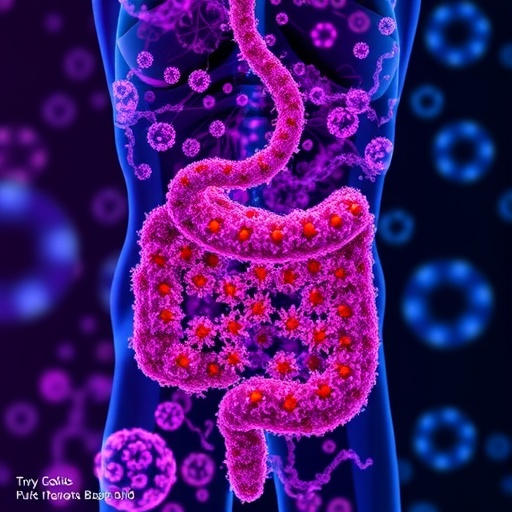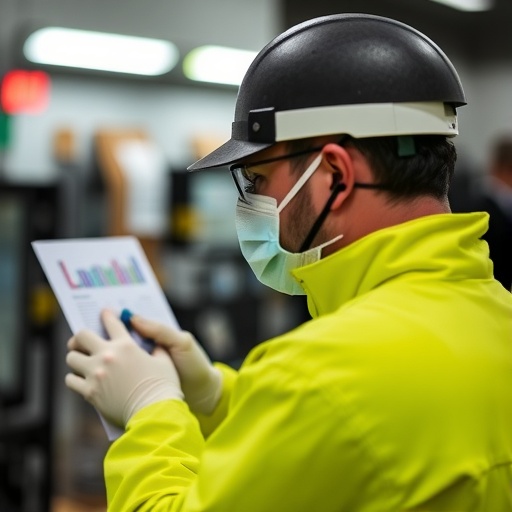In a groundbreaking revelation poised to reshape our understanding of oxygen chemistry, researchers have unlocked the intricate mechanisms governing the transformation of superoxide into its excited oxygen states. These findings delve deep into the subtle dance of electronic spin states, unveiling how the kinetic energy landscapes dictated by Marcus theory orchestrate the evolution of both triplet and singlet oxygen from superoxide radicals. Such insights are not merely academic; they harbor profound implications across biology, medicine, and energy technologies, where the nuances of reactive oxygen species dictate health, disease progression, and efficiency of redox systems.
At the heart of this discovery lies the concept of a common driving force that decisively influences the spin state outcome during superoxide oxidation. Superoxide, a reactive oxygen species with an unpaired electron, serves as a progenitor to two major oxygen states: triplet oxygen (^3O_2), the ground state, and singlet oxygen (^1O_2), an electronically excited and highly reactive species. Previously, the factors governing which state predominates remained ambiguous. This new research demonstrates that Marcus kinetics—a foundational framework describing electron transfer reactions—parts ways with conventional thought by revealing a bifurcated kinetic behavior characterized as ‘normal’ and ‘inverted’ regimes, which dictate the prevalence of each oxygen form.
Delving deeper, the team elucidates that the production of singlet oxygen becomes significant only as the kinetics for triplet oxygen formation enter their Marcus inverted region. In this counterintuitive regime, the rate of triplet oxygen evolution actually decreases when the driving force—or the energetic ‘push’ behind the reaction—increases beyond a threshold. This phenomenon creates a kinetic window allowing singlet oxygen formation to rival or even surpass triplet oxygen, a revelation that untangles previously puzzling experimental inconsistencies.
Moreover, the researchers shed light on the nuanced role of acidity and Lewis acidity in modulating oxygen species outcomes during superoxide disproportionation. Disproportionation reactions, wherein superoxide ions serve concomitantly as oxidants and reductants, are dramatically influenced by proton presence and Lewis acids. The study clarifies that increasing Brønsted acidity bolsters singlet oxygen generation by enhancing the driving force, while weaker Lewis acidity favors similar outcomes through reorganization energy modulation. This finding provides a vital chemical basis for the longstanding empirical observations linking pH and acidity to reactive oxygen species behavior.
Remarkably, the interplay between pH and oxygen species formation finds biological resonance. The research aligns with physiological environments, imprinting a clear connection between organelle-specific pH values and oxygen chemistry within. Mitochondria, known for their relatively higher pH, suppress singlet oxygen, protecting cellular machinery from oxidative damage. Conversely, lysosomes’ lower pH environment elevates singlet oxygen yield, potentially leveraging this reactive species for beneficial oxidative processes. This suggests a previously unrecognized evolutionary pressure shaping organelle pH to balance life’s oxidative needs and safeguards.
Extending these revelations to human-engineered redox systems, the study furnishes actionable strategies for mitigating the detrimental impact of singlet oxygen. In technologies ranging from fuel cells to photodynamic therapy, singlet oxygen’s reactivity often translates to material degradation and reduced efficiency. The findings recommend approaches such as lowering the driving force for superoxide oxidation, increasing molecular or interfacial reorganization energies, or circumventing conditions favoring superoxide disproportionation as viable pathways to suppress harmful singlet oxygen formation.
These insights spring from a meticulous combination of theoretical modeling and experimental validation grounded in Marcus electron transfer theory. The researchers map the reaction coordinates and reorganization energies associated with superoxide oxidation, revealing the kinetic nuances that pivot the chemistry toward either the common triplet or the reactive singlet state. This dual understanding empowers more predictive control over oxygen redox processes, opening doors to finely tuned biological and chemical environments.
Further implications resonate through life sciences, energy storage, and catalysis. In biological contexts, understanding how cells modulate singlet oxygen formation helps illuminate oxidative stress mechanisms and potential therapeutic targets. In energy storage, the optimized design of oxygen-involving reactions could alleviate degradation pathways, enhancing battery longevity and safety. Catalytic systems may also benefit by leveraging these kinetic controls to steer product selectivity and reaction pathways.
Importantly, the research underscores the broader concept of excited state electrogeneration, where the generation of electronically excited species via redox chemistry is a fundamental process. The findings elevate the understanding of spin state control beyond oxygen chemistry, implying that Marcus kinetics could serve as a universal tool for manipulating excited states in diverse chemical systems. Such advances promise transformative impacts in photochemistry, sensor design, and light-driven energy conversion technologies.
The study’s novel insights reconcile contradictory prior observations about singlet oxygen formation under various chemical oxidants and in proton- or Lewis acid-mediated disproportionation scenarios. This unification marks a paradigm shift that connects disparate experimental data under a cohesive theoretical framework. The precision afforded by Marcus kinetics offers a quantitative handle on reaction energetics, enabling researchers to predict conditions under which singlet oxygen’s reactive embrace will dominate or recede.
Crucially, the balance between normal and inverted regions in Marcus kinetics shines a spotlight on the delicate energy landscapes nature exploits. It clarifies that not simply energetic favorability, but the intricate interplay of kinetic barriers and reorganizational adjustments dictate spin state evolution. This appreciation mirrors broader themes in reaction dynamics, where timing and energy tuning are paramount in steering complex chemical phenomena.
In sum, this pioneering investigation unveils the kinetic mastery intrinsic to oxygen redox chemistry, illuminating how superoxide oxidation’s driving forces carve pathways to either stable triplet or reactive singlet oxygen. This deeper understanding empowers innovation across life science disciplines and energy technologies alike, heralding a new era of precision control over oxygen’s multifaceted chemical life.
Subject of Research: Oxygen redox chemistry and superoxide oxidation mechanisms.
Article Title: Marcus kinetics control singlet and triplet oxygen evolving from superoxide.
Article References: Mondal, S., Nguyen, H.T.K., Hauschild, R. et al. Marcus kinetics control singlet and triplet oxygen evolving from superoxide. Nature (2025). https://doi.org/10.1038/s41586-025-09587-7
Image Credits: AI Generated
Tags: electronic spin states in chemistrygroundbreaking oxygen chemistry researchimplications for biology and medicinekinetic energy landscapes in reactionsMarcus kineticsoxidation state outcomesreactive oxygen species dynamicsredox system efficiencysinglet oxygen productionsuperoxide radicals behaviorsuperoxide transformation mechanismstriplet oxygen evolution





